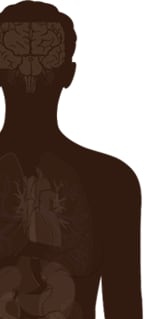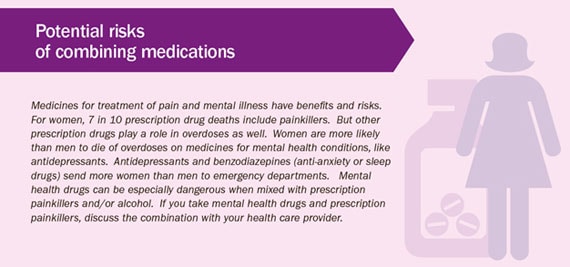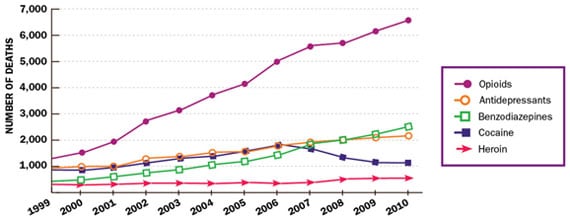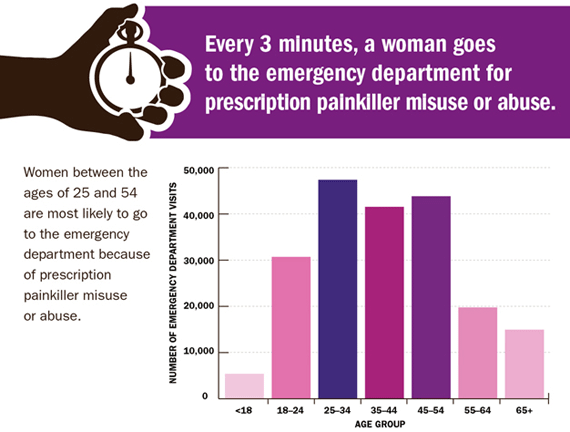Girls and Women Are Greatly Impacted by the Prescription Drug Epidemic Ravaging Our State
11/30/2016
When we think about those individuals impacted by the prescription drug epidemic we don't often think about its impact on young women as much as men, however, the alarming statistics provided by a recent report from the CDC highlight just how serious a problem this is for both men and women.
This stigma continues to stifle efforts to seek immediate professional help for those who are suffering from the disease of addition...if you know that your daughter, sister, wife, mother, or any other woman in your life needs assistance, contact the helpline at 800-238-2333 today.
from CDC.gov:
On this Page
July 2013


 48,000
48,000
Nearly 48,000 women died of prescription painkiller* overdoses between 1999 and 2010.
 400%
400%
Deaths from prescription painkiller overdoses among women have increased more than 400% since 1999, compared to 265% among men.
 30
30
For every woman who dies of a prescription painkiller overdose, 30 go to the emergency department for painkiller misuse or abuse.
About 18 women die every day of a prescription painkiller overdose in the US, more than 6,600 deaths in 2010. Prescription painkiller overdoses are an under-recognized and growing problem for women.
Although men are still more likely to die of prescription painkiller overdoses (more than 10,000 deaths in 2010), the gap between men and women is closing. Deaths from prescription painkiller overdose among women have risen more sharply than among men; since 1999 the percentage increase in deaths was more than 400% among women compared to 265% in men. This rise relates closely to increased prescribing of these drugs during the past decade. Health care providers can help improve the way painkillers are prescribed while making sure women have access to safe, effective pain treatment.
When prescribing painkillers, health care providers can
- Recognize that women are at risk of prescription painkiller overdose.
- Follow guidelines for responsible prescribing, including screening and monitoring for substance abuse and mental health problems.
- Use prescription drug monitoring programs to identify patients who may be improperly obtaining or using prescription painkillers and other drugs.
*"Prescription painkillers" refers to opioid or narcotic pain relievers, including drugs such as Vicodin (hydrocodone), OxyContin (oxycodone), Opana (oxymorphone), and methadone.
Problem
Prescription painkiller overdoses are a serious and growing problem among women.
- More than 5 times as many women died from prescription painkiller overdoses in 2010 as in 1999.
- Women between the ages of 25 and 54 are more likely than other age groups to go to the emergency department from prescription painkiller misuse or abuse. Women ages 45 to 54 have the highest risk of dying from a prescription painkiller overdose.*
- Non-Hispanic white and American Indian or Alaska Native women have the highest risk of dying from a prescription painkiller overdose.
- Prescription painkillers are involved in 1 in 10 suicides among women.
*Death data include unintentional, suicide, and other deaths. Emergency department visits only include suicide attempts if an illicit drug was involved in the attempt.
The prescription painkiller problem affects women in different ways than men.
- Women are more likely to have chronic pain, be prescribed prescription painkillers, be given higher doses, and use them for longer time periods than men.
- Women may become dependent on prescription painkillers more quickly than men.
- Women may be more likely than men to engage in “doctor shopping” (obtaining prescriptions from multiple prescribers).
- Abuse of prescription painkillers by pregnant women can put an infant at risk. Cases of neonatal abstinence syndrome (NAS)—which is a group of problems that can occur in newborns exposed to prescription painkillers or other drugs while in the womb—grew by almost 300% in the US between 2000 and 2009.

Prescription painkiller overdose deaths are a growing problem among women.


SOURCE: Drug Abuse Warning Network, 2010. (Suicide attempts are included for the cases (.03% of total) where opioids were combined with illicit drugs in the attempt.)
What Can Be Done
Federal government is
- Tracking prescription drug overdose trends to better understand the epidemic.
- Educating health care providers and the public about prescription drug misuse, abuse, suicide, and overdose, and the risks for women.
- Developing and evaluating programs and policies that prevent and treat prescription drug abuse and overdose, while making sure patients have access to safe, effective pain treatment.
- Working to improve access to mental health and substance abuse treatment through implementation of the Affordable Care Act.
Health care providers can
- Recognize that women can be at risk of prescription drug overdose.
- Discuss pain treatment options, including ones that do not involve prescription drugs.
- Discuss the risks and benefits of taking prescription painkillers, especially during pregnancy. This includes when painkillers are taken for chronic conditions.
-
Follow guidelines for responsible painkiller prescribing, including:
- Screening and monitoring for substance abuse and mental health problems.
- Prescribing only the quantity needed based on appropriate pain diagnosis.
- Using patient-provider agreements combined with urine drug tests for people using prescription painkillers long term.
- Teaching patients how to safely use, store, and dispose of drugs.
- Avoiding combinations of prescription painkillers and benzodiazepines (such as Xanax and Valium) unless there is a specific medical indication.
- Talk with pregnant women who are dependent on prescription painkillers about treatment options, such as opioid agonist therapy.
- Use prescription drug monitoring programs (PDMPs)—electronic databases that track all controlled substance prescriptions in the state—to identify patients who may be improperly using prescription painkillers and other drugs.
States can
- Take steps to improve PDMPs, such as real time data reporting and access, integration with electronic health records, proactive unsolicited reporting, incentives for provider use, and interoperability with other states.
- Identify improper prescribing of painkillers and other prescription drugs by using PDMPs and other data.
- Increase access to substance abuse treatment, including getting immediate treatment help for pregnant women.
- Consider steps that can reduce barriers (such as lack of childcare) to substance abuse treatment for women.
Women can
- Discuss all medications they are taking (including over-the-counter) with their health care provider.
- Use prescription drugs only as directed by a health care provider, and store them in a secure place.
- Dispose of medications properly, as soon as the course of treatment is done. Do not keep prescription medications around "just in case." (See www.cdc.gov/HomeandRecreationalSafety/Poisoning/preventiontips.htm)
- Help prevent misuse and abuse by not selling or sharing prescription drugs. Never use another person's prescription drugs.
- Discuss pregnancy plans with their health care provider before taking prescription painkillers.
- Get help for substance abuse problems (1-800- 662-HELP); call Poison Help (1-800-222-1222) for questions about medicines.
Science Behind the Issue
Related Pages
- CDC News Room - Digital Press Kit: Prescription Painkiller Epidemic Among Women
- Vital Signs Issue details: Morbidity and Mortality Weekly Report (MMWR): Vital Signs:Overdoses of Prescription Opioid Pain Relievers and Other Drugs Among Women — United States, 1999–2010
- Vital Signs – Prescription Painkiller Overdoses [PODCAST - 1:15 minutes]
- Vital Signs – Prescription Painkiller Overdoses [PSA - 0:60 seconds]
- Vital Signs – Prescription Painkiller Overdoses [SPANISH PODCAST - 1:30 minutes]
- Vital Signs: Prescription Painkiller Overdoses in the United States
- Policy Impact: Prescription Painkiller Overdoses
- Drug Overdose
- Medications and Pregnancy
- Key Findings: Maternal Treatment with Opioid Analgesics and Risk for Birth Defects
On Other Web Sites
- MedlinePlus - Medication Errors
- MedlinePlus - Women's Health
- MedlinePlus - Prescription Drug Abuse
- MedlinePlus - Pain Relievers
- MedlinePlus – Neonatal abstinence syndrome
- The White House - Office of National Drug Control Policy
- SAMHSA – Substance Abuse and Mental Health Services Administration
- Drug Enforcement Administration – Office of Diversion Control
- Drugs, Brains, and Behavior: The Science of Addiction
- Prescription Drugs
- U.S. Food and Drug Administration - Drugs Information
- National Institute of Mental Health
- MotherToBaby
- PDMP Center of Excellence, Brandeis University